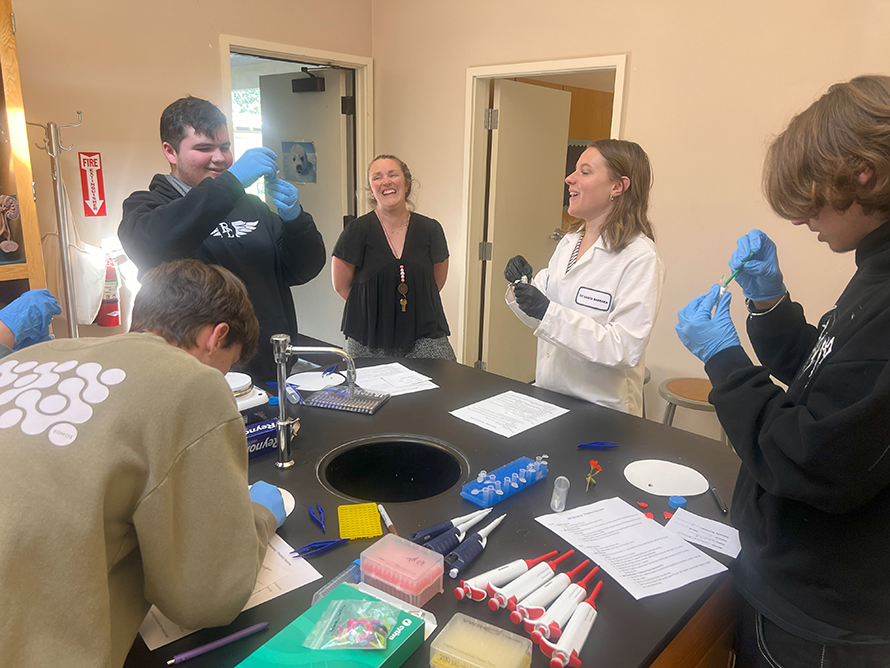Using DNA barcodes to capture local biodiversity
Extracting DNA barcodes from local plants and insects might sound like high-tech lab work, but thanks to Alana Deo’s team and their partnership with Cold Spring Harbor Laboratory, California residents are getting a hands-on opportunity to explore the biodiversity in their own backyards.
DNA barcodes, short segments of DNA about 700 nucleotides long, are well conserved across organisms but vary widely between species. This variation means that DNA barcodes act as a species-specific identifier, distinguishing one species from another, much like a fingerprint does for a person. Common DNA barcodes reside in the genes that encode mitochondria in animals and chloroplasts in plants.

At the University of California, Santa Barbara, fourth-year undergraduate Alana Deo and her team are collecting DNA barcodes with the aim of cataloguing local biodiversity. The team is enlisting the help of an unorthodox group of volunteers: the public.
“We really want to engage the public in scientific experiments,” Deo said. “We want them to feel like they're being a part of something and learning and be able to give those opportunities to people who might not have them otherwise.”
Deo’s team, using protocols and supplies provided by Cold Spring Harbor Laboratory DNA Learning Center, adapted a DNA barcoding procedure to allow kids, teens and adults to act as the researchers. At events hosted at local sites like a high school and the Santa Barbara Botanical Gardens, participants can collect their own samples of plants and insects from the surrounding area.
Participants then learn how to extract the DNA from their sample, amplify the DNA using PCR and confirm the results via gel electrophoresis. If they don’t have time for all the steps, Alana’s team finishes the job back at the lab.
After the hands-on activity with the public, Deo plans to send the samples off to be sequenced and analyzed. The sequences are ultimately published by Cold Spring Harbor Laboratory in GenBank, a database operated by the National Institutes of Health. Participants can track their samples on a webpage with the DNA barcode sequence of their sample. Each sequence collected and banked lists the citizen scientists’ names, giving them a window into science.
"Publishing the sequences on GenBank gives participants a genuine sense of scientific contribution,” Deo said. “It sparks their curiosity, deepens engagement in science, and empowers them to see themselves as true scientists.”
Deo hopes to expand this program into a summer camp for kids through SciTrek, a community outreach program founded at UCSB that aims to expose elementary and secondary students to science. The team’s collaboration with the public will allow them to document local biodiversity and ecological trends in the Santa Barbara area.
“Not only do we learn, the undergrads (also) learn, the professors learn, the teachers learn and the (volunteers) learn,” Deo said.

Enjoy reading ASBMB Today?
Become a member to receive the print edition four times a year and the digital edition monthly.
Learn moreGet the latest from ASBMB Today
Enter your email address, and we’ll send you a weekly email with recent articles, interviews and more.
Latest in Science
Science highlights or most popular articles

Bacteriophage protein could make queso fresco safer
Researchers characterized the structure and function of PlyP100, a bacteriophage protein that shows promise as a food-safe antimicrobial for preventing Listeria monocytogenes growth in fresh cheeses.

Building the blueprint to block HIV
Wesley Sundquist will present his work on the HIV capsid and revolutionary drug, Lenacapavir, at the ASBMB Annual Meeting, March 7–10, in Maryland.

Gut microbes hijack cancer pathway in high-fat diets
Researchers at the Feinstein Institutes for Medical Research found that a high-fat diet increases ammonia-producing bacteria in the gut microbiome of mice, which in turn disrupts TGF-β signaling and promotes colorectal cancer.

Mapping fentanyl’s cellular footprint
Using a new imaging method, researchers at State University of New York at Buffalo traced fentanyl’s effects inside brain immune cells, revealing how the drug alters lipid droplets, pointing to new paths for addiction diagnostics.

Designing life’s building blocks with AI
Tanja Kortemme, a professor at the University of California, San Francisco, will discuss her research using computational biology to engineer proteins at the 2026 ASBMB Annual Meeting.

Cholesterol as a novel biomarker for Fragile X syndrome
Researchers in Quebec identified lower levels of a brain cholesterol metabolite, 24-hydroxycholesterol, in patients with fragile X syndrome, a finding that could provide a simple blood-based biomarker for understanding and managing the condition.

